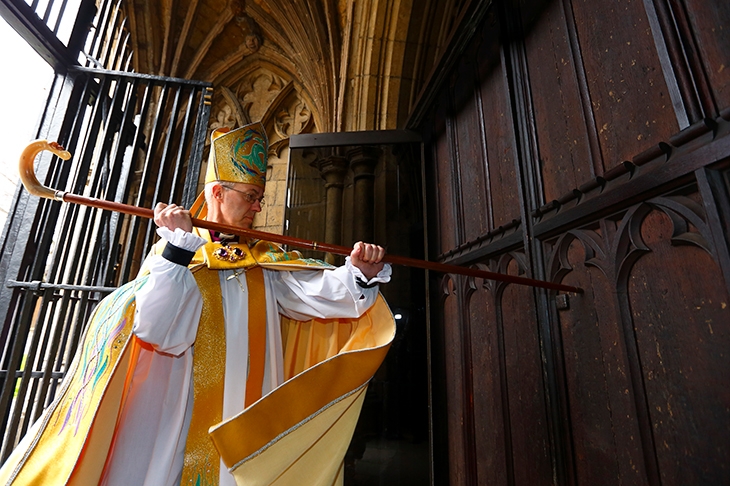‘Frost & Lewis’. It sounds like a programme amalgamating two of the most famous TV detectives. The former diplomat, Lord (David) Frost, is our chief Brexit negotiator and Oliver Lewis, an expert on the Irish aspects, is his right-hand man. Until recently, they were simply considered the two best men for the job. Since the departure of Dominic Cummings, they have acquired a political role too. Close colleagues of Cummings who did not walk out with him, they stayed to Get Brexit Done, so they act as reassurance to anxious Brexiteers that the government will not throw in the sponge. Their staying also implies a threat. Dom has said he doesn’t want anyone else to leave No. 10 — yet.
Tristram Hunt, director of the V&A, is a former Labour MP. In his Orwell Lecture on Monday night, he did a brilliant piece of Blairite triangulation. ‘Decolonising The Wonder House: Orwell, Empire and the Museum’ juxtaposed Orwell and Kipling and their views of empire. Hunt was quite bravely reminding people that Kipling’s father Lockwood had run the Lahore Museum along principles derived from the V&A (then the South Kensington Museum) where he had worked, and had argued the ‘philosophical, historical and aesthetic ground for the English in India to do all that lies in their power to foster her indigenous arts’. It was his father’s vision that created what Rudyard Kipling, in Kim, called ‘The Wonder House’. Hunt recognises that Kipling’s extraordinary imaginative grasp of India partly derived from this. On the other hand, he wishes to show he has no truck with imperialism, and so favours Orwell and his rejection of Kipling’s views. He seeks, against current ‘factionalism’, to enlist both men — ‘just as a knowledge of Kipling helps us understand Orwell, the reverse is also true’. Why? Hunt’s practical motive is to find a way through the minefields of the culture war which will allow his museum, whose collections are so indissolubly linked with imperial history, to keep them. His higher motive is to reassert, in modern form, the V&A’s civilising mission: ‘The role of the museum — with its galleries born of exchange, adaptation, and migration — is more important to civil discourse than ever.’
Hunt is right about that, and one truly wishes him all the best; but I think his triangulation puts him in the wrong place. He places himself as a moderate between two contending forces of unreason: ‘Too often, committed anti-racist campaigners seek to denounce all artefacts of imperial history outright, while many conservative polemicists fail to appreciate that the structures of race which underpinned the ideology of the British Empire still support inequality, prejudice and discrimination today.’ This is not the real situation. Conservative polemicists are not against museums presenting the full stories of colonial collections so long as we believe that those in charge truly care for them. It is what Hunt calls ‘the committed anti-racist campaigners’, currently led by Black Lives Matter, who are the zealots. They are not interested in the collections in their own right. They see them as symbols of one big evil thing called ‘colonialism’. So they want them, as they want Rhodes, to fall. Tristram Hunt is making the same mistake as the National Trust in thinking such people can be appeased. They are unfriendly to the very idea of a western museum or country house, unless it is turned into a morality play against the people who invented it.
Last week, I wrote about how Jesus College, Cambridge, seeking to dishonour its 17th-century slave-trading benefactor Tobias Rustat (while hanging on to his money), is trying to get a ‘faculty’ from the Church of England to remove his memorial from its chapel. The Master, Sonita Alleyne, says the relevant diocese (Ely) is ‘very supportive of our considerations’. If true, the diocese is jumping the gun. The granting of a faculty is a matter of law, the ecclesiastical equivalent of planning consent, not political grandstanding. The chancellor of the diocese must get the opinion of its advisory committee, which contains historical, architectural and aesthetic experts. Historic England is involved. The presumption of the system is that the Church is against removing monuments, so only a rigorous ‘statement of need’ can justify removal. If disputed, the matter may be heard by a consistory court. That court’s decision can be appealed to the Court of Arches, the highest ecclesiastical court. Earlier this year, speaking off the top of his mitre, the Archbishop of Canterbury, Justin Welby, said, apropos of slavery rows, ‘Some [statues] will have to come down’, so he may welcome such a court battle. His Church Buildings Council is currently drafting diocesan guidelines about this. But if it were decided that the Rustat memorial could be moved because its custodians don’t like its subject, where will that end? Is there a historic church or chapel in England whose fabric is safe?
A university project called ‘Odeuropa’ seeks to identify, catalogue and even re-create the smells of the past. This is a good idea. Smells are triggers for the memory but, because they cannot be easily preserved, they become lost to future generations. One smell being researched is that of tobacco, once almost omnipresent. I hope national differences can be captured. In my boyhood, cigarettes in France smelt much pleasanter than English ones. This favourably coloured my attitude to an entire country. An unpleasant smell which no one under 50 will know is that of ‘town gas’ — used for cooking and heating before ‘natural’ gas was extracted from the North Sea. It had, when not lit, a sickly sweet odour deliberately inserted by the suppliers because the gas was poisonous, so people needed to be able to detect leaks. You could smell it in all connected homes and in streets near gasworks. As its name suggests, it was not supplied in rural areas. So, in my country-boy memory, it has an oppressive association: that in a town you can’t breathe properly.







Comments